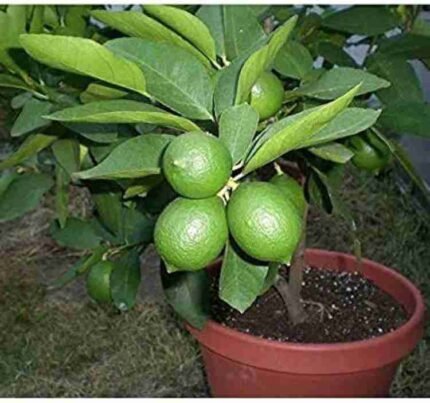Tree
- The guava tree is a small to medium-sized evergreen tree, generally growing to a height of 3–10 meters.
- It has a dense, spreading canopy with smooth, brownish or grayish bark.
- Guava trees are hardy and can tolerate drought conditions once established.
Leaves
- The leaves are opposite, ovate to elliptical in shape, with a smooth, leathery texture.
- They are dark green on the upper side and lighter beneath, with a strong fragrance when crushed.
Flowers
- Guava trees produce small, fragrant white or pink flowers, usually with five petals and numerous long, white stamens.
- These flowers are pollinated by insects like bees and butterflies, which are attracted to their sweet aroma.
Fruit
- The fruit is a rounded or oval berry, with a smooth or slightly rough skin.
- It can be green, yellow, or pink when ripe, depending on the variety.
- The flesh of the guava is typically juicy, with a sweet to slightly tangy taste, and it contains small, hard seeds in the center. The seeds are edible but can be discarded in processed products.
Growth and Cultivation in India
- Climate:
- Guava thrives in tropical and subtropical climates, making it ideal for cultivation across India, particularly in states like Uttar Pradesh, Andhra Pradesh, Maharashtra, Tamil Nadu, and Gujarat.
- It prefers warm weather, with temperatures between 20°C and 30°C, and can tolerate some drought conditions.
- Soil:
- Guava grows best in well-drained, sandy loam or red soil with a slightly acidic to neutral pH (5.5–7.0).
- Good soil fertility is essential for higher yields, and the tree is adaptable to a variety of soil types.
- Propagation:
- Guava is primarily propagated through seeds, but vegetative methods like grafting and air layering are also used to produce superior quality fruit.
- Grafted trees typically start fruiting earlier than seed-grown ones and are more consistent in yield.
- Watering and Irrigation:
- Though guava trees are drought-tolerant, they still require regular watering, especially during the flowering and fruiting stages.
- Drip irrigation is commonly used in Indian guava orchards to conserve water and promote better fruit development.
- Pruning:
- Pruning is essential for shaping the tree, removing dead wood, and encouraging better fruiting. Regular thinning of branches also allows sunlight to reach the inner parts of the tree, improving fruit quality.
Uses and Benefits in India
- Nutritional Value:
- Guavas are rich in dietary fiber, vitamin C, vitamin A, folate, and antioxidants.
- A single guava can provide more than twice the daily requirement of vitamin C, making it a powerful immune booster.
- The high fiber content aids in digestion and helps prevent constipation, which is why guava is often recommended in traditional Indian medicine.
- Culinary Uses:
- Guavas are consumed fresh, juiced, or used in various dishes.
- In India, they are used to make jams, juices, chutneys, candies, and even savory dishes like guava curry in some regions.
- Ripe guavas are also used in desserts, while unripe guavas are commonly enjoyed with salt, chili powder, and black pepper as a tangy snack.
- Medicinal Properties:
- Guava leaves are used in traditional Indian medicine for their antimicrobial, anti-inflammatory, and astringent properties. Guava leaf extracts are sometimes used to treat digestive disorders, reduce blood sugar levels, and alleviate skin issues.
- Guava fruits, especially when consumed regularly, are believed to help control blood pressure, improve heart health, and boost immunity.
- Economic Importance:
- Guava is an economically significant fruit crop in India, providing livelihoods to many farmers. The fruit is sold fresh in local markets, but it also has a thriving processed goods industry, producing jams, juices, and pickles.
- The production of guava is also an important aspect of India’s agricultural export industry, especially in the form of processed products like guava pulp.
Varieties
India cultivates several varieties of guava, each with its own unique characteristics. Some popular varieties include:
- Lucknow-49: Known for its high yield, excellent taste, and small seeds, this variety is popular in northern India.
- Pink Guava: This variety has pink-colored flesh, which is sweet and aromatic.
- Apple Guava: Known for its large size, crisp texture, and mild sweetness.
- Allahabad Safeda: A white-fleshed variety with a soft, sweet taste, commonly found in Uttar Pradesh and Maharashtra.
Pests and Diseases
Guava trees are susceptible to a variety of pests and diseases. Some common issues include:
- Fruit flies: These insects lay eggs in the fruit, making it unfit for consumption.
- Guava wilt: A fungal disease that causes the tree to wilt and eventually die.
- Leaf spot and powdery mildew: Fungal infections that affect the leaves, reducing the tree’s productivity.
Proper pest management practices, such as the use of insect traps, organic pesticides, and maintaining good orchard hygiene, are essential to ensure healthy guava trees and good fruit yield.










Mr. Mackay –
A seemingly elegant design can quickly begin to bloat with unexpected content or break under the weight of actual activity. Fake data can ensure a nice looking layout but it doesn’t reflect what a living, breathing application must endure.